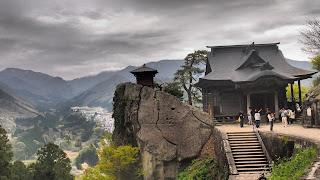I have had a wonderful few days here in Nagasaki, it is a very interesting city and it's easy to get around.
Well before the events of 1945 Nagasaki was an important and historical place and lots of its early history reminded me of what happened in Malacca. It was one of the first places to have contact with the West, firstly through the Portuguese and then the Dutch. When Japan closed its borders during the Edo period and entered a long spell of isolation, Nagasaki was the only place allowed to have contact with the outside world and the Dutch traded on a small man made island called Dejima in what was then the harbour. When Japan came out of isolation in the 1850s Nagasaki flourished once again and a large foreign settlement grew up here, boosting the city's reputation in trade and business as well as enabling it to play a huge part in the modernisation of Japan. Despite extensive damage from the blast and subsequent fires much has been done to restore buildings and sites from these earlier times and I really enjoyed visiting Dejima, which has been reclaimed, excavated and restored, even though due to land reclamation it is now slightly inland. I also spent lots of time at the Glover Garden, named after a Scottish man who came to Nagasaki in 1859 and set up the Glover trading company. The Gardens are close to the former foreign settlement and many of the old colonial houses have been restored and moved here to recreate that era-although this might sound cheesy it wasn't, I learned loads and the house and views were stunning. It was interesting to learn that Puccini was a close friend of Glover and used to visit him in Nagasaki, using his time here as inspiration for his opera Madame Butterfly. Using my one day tram pass I also went to China Town and up to Mount Inasa for some spectacular night views ( you'll have to take my word for it because the photos I took are crap).
Today I pottered a little more and discovered various temples and shrines close to my hotel, including the Fukisajii Temple, which features a giant tortoise. I spent some time in the History and Culture Museum and wandered by the river to see the oldest bridge in the city.
There are memories of August 1945 everywhere, many important religious building were destroyed but have been reconstructed in the previous sites. The epicentre of the blast was a couple of miles inland in a residential area, close to a big Catholic cathedral and there is now a museum, memorial and peace park here. The museum was moving and I'm glad I went. It is a testament to the city that although this part of history is acknowledged it has not defined the place.
I was feeling a bit lonely when I got here, especially after having such a laugh with Cathal recently but I have met some nice people here: a couple from Tokyo who spoke no English but could speak Spanish, which made for a fun conversation and a lovely man who walked me back to my hotel this afternoon on his way to the library, he was born in 1939 and had recently returned to Nagasaki after years working away.
The food is interesting here because of all of the foreign influences. A local speciality is something called Turkish Rice, which seems to involve flavoured rice, spaghetti and meat in a rich sauce all on the same plate...
Moving on tomorrow to Hiroshima and I'm aware that my trip looks like some sort of disaster spot tourism but it will break up my journey to Kyoto and Osaka and I'm going to fit in a small coastal town called Onomichi to break from the theme.
 |
| The bomb hypocentre |
 |
| The Peace Park |
 |
| Dejima |
 |
| Dejima |
 |
| On the Wharf |
 |
| Glover Garden |
 |
| Glover Garden |
 |
| Glover Garden |
 |
| Glover Garden |
 |
| Glover Garden |
 |
| night time view ( I warned you ) |
 |
| Yes it is a tortoise |
 |
| School kids with carp in the river |
 |
| View from a bridge |
 |
| Spectacles Bridge ( because of the reflection) |
























































